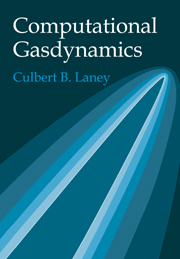Part V - Advanced Methods of Computational Gasdynamics
Published online by Cambridge University Press: 07 December 2009
Summary
Logically, all things are created by a combination of simpler, less capable components.
Dogbert in Dilbert by Scott AdamsThis part of the book concerns solution-sensitive methods. After possibly accounting for the wind direction, the first-generation methods studied so far mindlessly treat every part of the solution the same, regardless of how the solution behaves. The solution-sensitive methods studied in Part V combine a range of first-generation methods, varying the exact blend from place to place based on solution features such as shocks. For example, a solution-sensitive method might use Roe's first-order upwind method at shocks and the Lax–Wendroff method in smooth regions. Most solution-sensitive methods decide what to do based on solution gradients or flux gradients; large gradients indicate shocks or other features with the potential to cause trouble in the polynomial interpolations underlying most numerical methods.
In the literature, solution-sensitive methods are commonly called high-resolution or TVD methods. Less common terms include hybrid, adaptive, self-adjusting, averaged, reconstructed, essentially nonosdilatory, combination, corrected, and limited methods. No one book could describe the huge number of solution-sensitive methods suggested in the research literature. Part V includes methods based partly on historical significance and influence, partly on how well they exemplify general principles and notations, partly on current popularity, and partly on the author's personal tastes.
Many solution-sensitive methods explicitly enforce nonlinear stability conditions, such as the upwind range condition or the TVD condition. Stability conditions reduce spurious oscillations near shocks, but they also typically impose clipping errors at solution extrema. Although combination methods have trade-offs, these are far less severe than for the fixed methods studied in Part IV.
- Type
- Chapter
- Information
- Computational Gasdynamics , pp. 455 - 458Publisher: Cambridge University PressPrint publication year: 1998



